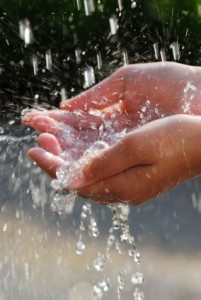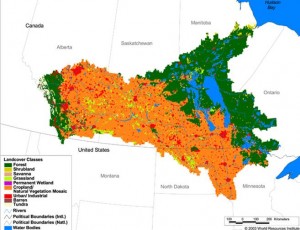 With climate change, water will become an overall more precious and precarious resource in Manitoba.
With climate change, water will become an overall more precious and precarious resource in Manitoba.
On this page, we deal with these aspects of adapting to climate change influenced water issues:
- Key issues
- Floods and droughts
- Hydroelectricity
- Adaptive strategies
Click a link in the list above to jump to that topic on this page.
Key issues
Floods and droughts
Water scarcity has always been a concern on Canada’s Prairies. In the mid 1800s Captain John Palliser identified the Western Canadian Prairies (the “Palliser Triangle”) as an arid region unsuitable for settled cultivation, in which disaster would befall those who tried to settle it (1).
 Most computer models project a slight to no increase in average total annual precipitation this century (2). However, it is most likely that the timing and nature of the precipitation will change.
Most computer models project a slight to no increase in average total annual precipitation this century (2). However, it is most likely that the timing and nature of the precipitation will change.
In the coming century we could see
- more of our annual allotment of precipitation occur in the winter and spring and less in the summer (3)
- more winter precipitation as rain rather than snow due to higher winter temperatures (4)
- more high-precipitation severe storm events (5)
- increased frequency of early season flooding (6)
- increased frequency of drought years (7)
- a decrease in soil moisture, even with higher annual precipitation, because of increased evaporation (8)
Results of these changes include lower summer stream flows, falling lake levels, retreating glaciers, and increasing soil- and surface-water deficits. A trend of this increased dryness will most likely be realized through a greater frequency of dry years especially in Manitoba’s southwest. (9) Drier soils over time will lower the ground-water tables. Less water will also threaten the quality of what remains in the rivers, lakes and ponds.
To explore the changes in precipitation for Manitoba and the rest of Canada, try the Prairie Climate Centre‘s interactive map tool, found here.
Hydroelectricity
Droughts would further impact Manitobans due to our reliance on water for electricity production. Since most of our hydroelectricity comes from the Nelson River, we are also very dependent upon Rocky Mountain glaciers and snowpack. Both of which are threatened.
Figure 1 shows a map of the Nelson River watershed.
An example of Manitoba Hydro’s dependence on these water sources can be seen in the drought year 1988. Manitoba experienced only a 4% decrease in hydroelectric power generation compared to normal years. However, this resulted in a 72.6% drop in export sales from the previous year and a net income loss of $26.4 million (10).
In 2004, Manitoba Hydro again posted a net loss – this time for $436 million. And again, this loss was primarily due to the prolonged drought conditions of 2003 (11).
Adaptive strategies
In general, we will need to:
- ensure that we retain the water we have in locations where it can be preserved, protected, and accessed when we need it
- reduce water usage and only use what we need
- have infrastructure and emergency management systems to deal with larger and more frequent floods
To implement adaptive strategies we may need to:
- adopt technologies for improved efficiency of water use
- consider water pricing regimes to more accurately reflect the real costs of water treatment and supply, and to help ensure that an increasingly scarce resource is properly allocated (12)
- develop an integrated water resources management and governance system that is based on the boundaries of the watershed rather than provincial, municipal, or departmental boundaries (13)
- adjust operating rules of water resource systems (given earlier spring runoff and increased summer water demands) to increase system efficiency and capacity (14)
- change the timing of irrigation to after sunset and using more efficient irrigation methods (15)
- issue licenses to jurisdictions and industries based on best water management practices and water recycling standards (16)
- continue and expand holistic watershed management (17)
- encourage community level adaptation to climate change for watershed-scale management authorities (18)
- develop a comprehensive adaptation strategy for Manitoba Hydro to ensure its domestic and export obligations can be met during long-term low-water event





